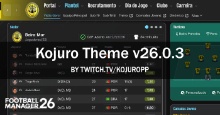
About Franscisco Farioli
At just 36, Farioli is often tagged as “Football’s Philosopher”, a moniker earned not just by his age, but by a coaching methodology uniquely driven by an academic background in philosophy.This is not a coach who simply follows trends. This is a coach who sees football as an “expression of the self”, rejecting external statistical dogma in favour of an authentic, yet meticulously structured, possession-based system.
Farioli’s vision stems directly from his university studies at the University of Florence. He authored a thesis titled ‘Football as rebirth: the aesthetics of the game and the role of the goalkeeper,’ which defines his unique lens on the game.
While his mentor, Roberto De Zerbi, is his clearest tactical predecessor, Farioli is seen as building upon the high-risk build-up principles by adding his own layer of defensive solidity and control.
Farioli's Tactical Identity
Farioli’s system is not merely a high-press, possession side; it is a meticulously calculated strategy to manage risk and exploit specific areas of the pitch.The most unique aspect of Farioli’s 4-3-3 is the creation of a 5-man central unit when attacking, which ensures control and effective defensive stability.
The low tempo and short passing in the defensive third serve a single, daring purpose: to lure the opposition’s press.
Once the ball is past the first press, the team’s shape is designed to maximise creative output in the half-spaces.
Farioli demands aggression and exceptional organisation when the ball is lost. The press is immediate, and the deeper defence is highly compact.
To successfully replicate Farioli’s system, players must possess high Composure, Passing, Off The Ball movement, and Work Rate.
The FM26 Tactic
We are achieving Domestic Dominance through a statistically overwhelming attack and a structurally secure defence.
The below captures the most frequent plays and connections between the wide players - that means the fullbacks and wingers. Why them? Because their link-up is absolutely crucial for a solid build-up and, most importantly, for creating chances in the final third.
We’re deliberately running two distinct tactical setups on the flanks, and the differences are fascinating.

The Left Flank - Precision and Playmaking:
On the left, we’ve built a triangle designed for elite connection. It features Moura, who is an elite passer, paired with Sainz, a classic direct runner. The system is anchored by Veiga, a top-tier ball receiver and playmaker operating in the half-space. The key here is the direct passes from Moura into Veiga—these vertical deliveries into the half-space are absolutely vital for our build-up and penetration.
The Right Flank - Carrying and Versatility:
The right side offers a different profile. Costa is a less expressive passer than Moura, but he’s a significantly more effective ball carrier. This is paired with Pepê, a true hybrid who can switch between creation and running. Up front, Froholdt will likely play higher, constantly making movements in behind the defence. This advanced role by Froholdt is the catalyst: it creates the necessary space for Costa to invert and generate crucial overloads in the right channel. This flexibility means Gomes can fluidly shift between being ball-dominant and being primarily movement-focused.

Further Reading
For further tactical analysis on this tactic, check out the original article on substack.If this has been of interest, check out the thread over on the SI Forum which explores Farioli’s game model in much more detail.






![[FM26] Leagues Mega Pack by @Timo@ (204 Nations + 24 Feminines + 7 Others)](assets/downloads/fm26/fm26-leagues-pack-by-timo.th.png)


Discussion: The Philosopher: Farioli's Porto 4-3-3 Possession
No comments have been posted yet..